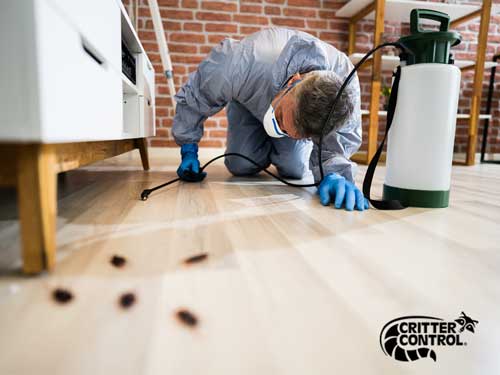Bed Pest Therapy Malfunction: Contrasting Chemical Vs. Non-Chemical Solutions
In the world of pest control, specifically when taking care of the consistent problem of bed bugs, the option between chemical and non-chemical treatment services can be a crucial one. Both methods provide distinct advantages and drawbacks, influencing variables such as performance, safety considerations, and general cost. By taking a look at the nuanced details of each approach, a clearer understanding of which course to go after in attending to a bed insect problem can be obtained.
Efficiency of Chemical Treatments
Chemical therapies for bed pest problems have been extensively identified for their fast and powerful efficacy in removing these pests. When thinking about the effectiveness of chemical therapies, it is essential to comprehend that they can supply a complete and fast service to a bed insect issue. Professional exterminators frequently rely upon pesticides to target bed insects at different stages of their life process, consisting of eggs, grownups, and fairies. These chemicals commonly work by disrupting the bed insects' nerve system, bring about paralysis and ultimate fatality.
Furthermore, chemical treatments have the advantage of supplying residual results, implying that they can remain to get rid of bed bugs also after the initial application. This residual action is specifically valuable in combating any kind of prospective re-infestations. Additionally, the rapid action of chemical therapies can bring alleviation to individuals encountering serious bed pest invasions, enabling them to regain control of their home quickly.
Safety Problems With Chemical Solutions
One important element that calls for cautious factor to consider when making use of chemical services for bed pest treatment is ensuring the security of owners and the atmosphere. Direct exposure to certain chemicals made use of in bed pest treatments can lead to breathing concerns, skin inflammation, or various other damaging reactions, particularly in people with pre-existing problems or sensitivities.
Furthermore, the environmental influence of chemical solutions is one more significant factor to consider. Some chemicals utilized in bed insect therapies might be unsafe to helpful insects, wild animals, and environments if they leach into the dirt or water systems. It is vital to make use of chemical treatments deliberately, adhering to safety guidelines, and thinking about less poisonous choices to minimize these risks and make certain the secure and efficient monitoring of bed insect infestations.
Benefits of Non-Chemical Methods
Considering the potential safety and security problems and ecological effect connected with chemical services for bed insect therapy, discovering non-chemical techniques presents an encouraging alternative with numerous distinctive advantages. Non-chemical therapies are environmentally pleasant, as they do not add to air or water pollution, making them a lasting option for insect control.
Additionally, non-chemical services can be reliable in targeting bed insects, consisting of hard-to-reach areas where chemical treatments might not penetrate. Approaches such as heat therapy, vacuuming, vapor cleaning, and cushion encasements supply complete elimination without the use of dangerous chemicals. Furthermore, non-chemical strategies can be much less disruptive, requiring very little preparation and enabling quicker reentry right into treated locations. In general, going with non-chemical bed bug therapy methods not just focuses on security and environmental protection however additionally ensures effective and thorough parasite control.
Limitations of Non-Chemical Treatments

In addition, non-chemical treatments typically call for numerous applications to achieve successful elimination. This can be taxing and may not always assure total removal of all bed bugs and their eggs, specifically in covert or hard-to-reach areas.
Furthermore, the success of non-chemical therapies greatly relies upon proper execution and thoroughness, which can be challenging for people without specialist experience. Inadequate great site application of non-chemical methods might cause insufficient obliteration, causing consistent problems and the demand for extra treatments.
As a result, while non-chemical therapies have their advantages, it is important to acknowledge these limitations and consider them when establishing one of the most effective approach for managing bed bug problems.
Cost Contrast: Chemical Vs. Non-Chemical Options
Given the limitations associated with non-chemical therapies, a crucial aspect to review in the context of bed bug monitoring is the price contrast between chemical and non-chemical choices. In comparison, non-chemical treatments like warmth therapy or vapor can be more expensive, with expenses varying from $1,000 to $6,000 for a whole home. While the preliminary cost of chemical treatments might appear reduced, several treatments may be required to completely get rid of the infestation, potentially enhancing visite site the overall expense.
Verdict

Thinking about the possible safety and security problems and environmental impact linked with chemical services for bed insect therapy, exploring non-chemical techniques offers a promising alternative with numerous distinct advantages.Provided the restrictions connected with non-chemical treatments, a crucial element to examine in the context of bed pest monitoring is the price comparison between chemical and non-chemical alternatives. In comparison, non-chemical treatments like warmth treatment or steam can be extra expensive, with costs ranging from $1,000 to $6,000 for an entire home. While the initial cost of chemical therapies might appear reduced, several therapies may be needed to totally get rid of the problem, possibly raising the total price.In verdict, when contrasting chemical and non-chemical you could try this out bed pest therapy options, it is necessary to take into consideration effectiveness, safety, advantages, constraints, and price.
Comments on “Effective A1 Bed Bug Treatment in Charlotte - Safe and Proven Methods”